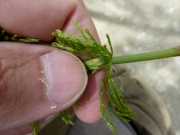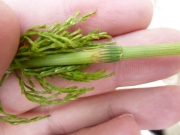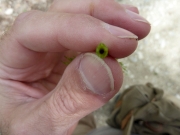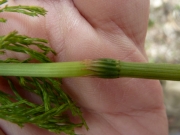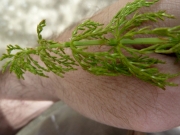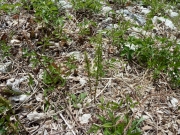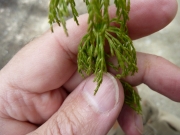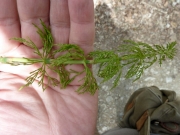Transformational Gardening
April 2012 Foraging Experiences
(Forward to:
May 2012 Foraging Experiences)
April 7, 2012
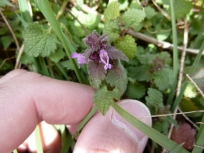
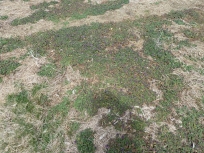 At first I thought this was a huge plot of Ground Ivy (Glechoma hederacea).
It has a similar look. But Ground Ivy grows closer to the ground and roots at the
nodes while Lamium species do not. Purple Deadnettle has a purple flower with
a hairy, curved hood/lip at the top and two lobes at the bottom. Ground Ivy has a
bluish-purple flower with no hood at the top, a big and slightly split lobe at the
bottom middle and two smaller lobes on each side of the bottom lobe.
At first I thought this was a huge plot of Ground Ivy (Glechoma hederacea).
It has a similar look. But Ground Ivy grows closer to the ground and roots at the
nodes while Lamium species do not. Purple Deadnettle has a purple flower with
a hairy, curved hood/lip at the top and two lobes at the bottom. Ground Ivy has a
bluish-purple flower with no hood at the top, a big and slightly split lobe at the
bottom middle and two smaller lobes on each side of the bottom lobe.
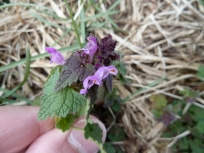
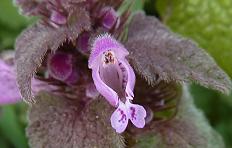 There are other Lamium species in New Hampshire:
There are other Lamium species in New Hampshire:
- Common Henbit (Lamium amplexicaule): Leaves are less triangular and more
heart-shaped. Less densely-bunched leaves on the stem. Upper leaves and bracts are
sessile and clasping (while all of the upper leaves on Purple Deadnettle are petiolate).
Pointy calyx lobes at the bottom of the flower tube are straight (while the calyx lobes
on Purple Deadnettle are spreading).
- Spotted Henbit (Lamium maculatum): Leaf blades commonly have a white blotch
bordering each side of the midrib. Terminal tooth on upper leaf blades are usually
blunt or rounded. Flower longer than that of Purple Deadnettle with a much bigger
and longer hood/lip at the top of the flower.
Purple Deadnettle is edible. I will definately go back for a harvest soon!
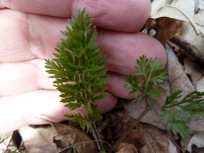
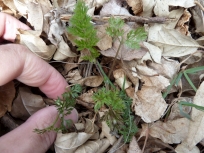 There were no other Queen Anne’s Lace (Wild Carrot) plants in the area,
so I decided not to dig this one up to eat the root.
There were no other Queen Anne’s Lace (Wild Carrot) plants in the area,
so I decided not to dig this one up to eat the root.
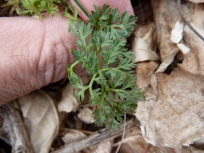
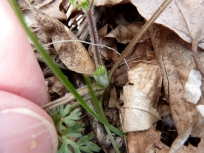 Notice in the last picture (below) how hairy the stems are.
Poison Hemlock (Conium maculatum) has similar-looking leaves,
but is smooth and without hairs.
Notice in the last picture (below) how hairy the stems are.
Poison Hemlock (Conium maculatum) has similar-looking leaves,
but is smooth and without hairs.
April 8, 2012
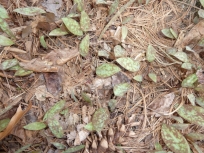
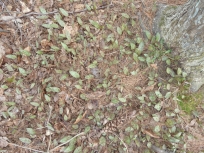 Luckily, I looked through the calendar section of Arthur Haines' excellent book,
Ancestral Plants (Volume 1) to see what would be available to collect in early
April. American Trout-Lily bulbs were one of several available to collect and from
last year I knew exactly where to find them!
Luckily, I looked through the calendar section of Arthur Haines' excellent book,
Ancestral Plants (Volume 1) to see what would be available to collect in early
April. American Trout-Lily bulbs were one of several available to collect and from
last year I knew exactly where to find them!
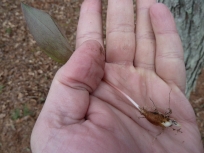
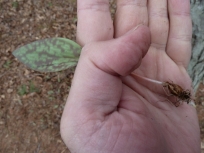 They are much harder to collect than expected. Not only are the bulbs deep in the ground
(for such a small plant), but tree roots get in the way of digging. It take patience
-- much more than I had today. I ate some raw and they were a little bland, but not
bad. I steamed the leaves and bulbs in a metal steamer. Steamed American Trout-Lily
leaves are very good. Last year, when I cooked the leaves in water, they got too
soggy and weren't very good, but steaming is the way to go. The bulbs were just as
bland cooked as raw.
They are much harder to collect than expected. Not only are the bulbs deep in the ground
(for such a small plant), but tree roots get in the way of digging. It take patience
-- much more than I had today. I ate some raw and they were a little bland, but not
bad. I steamed the leaves and bulbs in a metal steamer. Steamed American Trout-Lily
leaves are very good. Last year, when I cooked the leaves in water, they got too
soggy and weren't very good, but steaming is the way to go. The bulbs were just as
bland cooked as raw.
But the best find of this little trip was a “motherload” of:
Orpine
(Witch's Moneybags, Livelong, Frog's-stomach, Live-forever) (Hylotelephium telephium) (Previously: Sedum telephium)
I saw at least a hundred little baby Orpine plants between the marsh and the trail.
April 9, 2012
Common Dandelion (Taraxacum officinale)
and
Garlic Mustard (Jack-by-the-Hedge) (Alliaria petiolata) (Previously: Alliaria officinalis))
and
Ground Ivy (Glechoma hederacea)
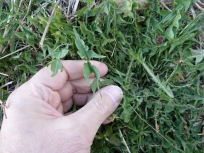
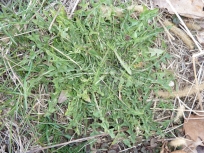 Last year I focused on learning to identify a variety of edible and non-edible plants.
This year I want to focus on foraging and using wild plants regularly. Today, I went
to the overgrown public gardens area and picked some Common Dandelion, Ground Ivy and
a few leaves of Garlic Mustard for a vegetable medley. I steamed the vegetables and they
were surprisingly mild and good. But it could have used some salt, come to think of it.
Last year I focused on learning to identify a variety of edible and non-edible plants.
This year I want to focus on foraging and using wild plants regularly. Today, I went
to the overgrown public gardens area and picked some Common Dandelion, Ground Ivy and
a few leaves of Garlic Mustard for a vegetable medley. I steamed the vegetables and they
were surprisingly mild and good. But it could have used some salt, come to think of it.
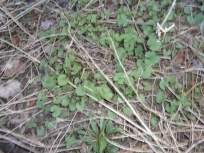
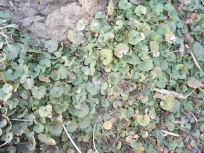 A couple of things I noticed were that the Common Dandelion grow in direct sunlight and
the leaves had sharp teeth. I expected the leaves to be bitter (since it is my understanding
that dandelion grown in shade is less bitter), but it was mild. This may be due to the
leaves being so young. Adding a few Garlic Mustard leaves did not make the dish bitter.
I have read that bigger, older Garlic Mustard leaves tend to be less bitter.
A couple of things I noticed were that the Common Dandelion grow in direct sunlight and
the leaves had sharp teeth. I expected the leaves to be bitter (since it is my understanding
that dandelion grown in shade is less bitter), but it was mild. This may be due to the
leaves being so young. Adding a few Garlic Mustard leaves did not make the dish bitter.
I have read that bigger, older Garlic Mustard leaves tend to be less bitter.
Even though it was cold and windy, I love going “shopping” like this.
Time to make it a regular habit! The last picture shows drying dandelion root for
tea.
April 15, 2012
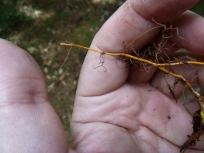
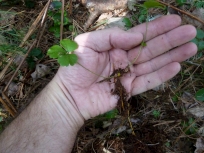 This is one of the best medicines for sore throats. Both the golden root and the above-ground
part of the plant can be used to make a tincture or tea. In addition, the root can be chewed
for immediate effect. The root is so bitter that it will make you forget that you have
a sore throat. In fact, the bitterness will make you forget you have a throat at all!
This is one of the best medicines for sore throats. Both the golden root and the above-ground
part of the plant can be used to make a tincture or tea. In addition, the root can be chewed
for immediate effect. The root is so bitter that it will make you forget that you have
a sore throat. In fact, the bitterness will make you forget you have a throat at all!
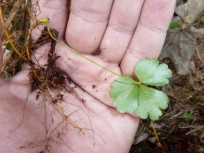
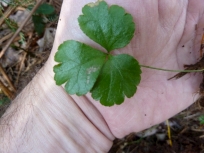 I am not sure why I could not find this plant last year. It is all over the place in
this forest of Eastern White Pine, Eastern Hemlock and American Beech trees.
I am not sure why I could not find this plant last year. It is all over the place in
this forest of Eastern White Pine, Eastern Hemlock and American Beech trees.
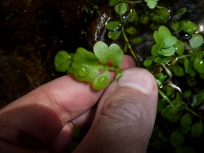
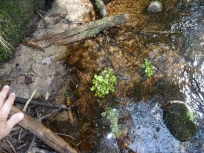 This plant was growing in a 30-foot wide, 6-inch to 2-feet deep stream. Some of the
plants were partially above the water and some were in the middle of the steam several
inches below the water. It looked like watercress. After futile attempts to confirm
identification, I sent a couple of pictures to Arthur Haines and he suggested that
it looks like Pennsylvania Bittercress, but he couldn't be certain from the two pictures
I sent.
This plant was growing in a 30-foot wide, 6-inch to 2-feet deep stream. Some of the
plants were partially above the water and some were in the middle of the steam several
inches below the water. It looked like watercress. After futile attempts to confirm
identification, I sent a couple of pictures to Arthur Haines and he suggested that
it looks like Pennsylvania Bittercress, but he couldn't be certain from the two pictures
I sent.
Pennsylvania Bittercress is not bitter, but it is a fantastic green that can be eaten
raw or cooked. When eaten raw it has a nice, horseradish-like taste. After cooking,
it becomes much more mild. I picked a bunch to eat and enjoy.
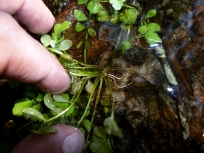
 I will need to do more work to confirm identification. I have narrowed it down to one
of the following:
I will need to do more work to confirm identification. I have narrowed it down to one
of the following:
- Pennsylvania Bittercress (Cardamine pensylvanica)
- Pink Cuckoo Bittercress (Cardamine pratensis var. palustris) -- From a drawing
I have seen, the palustris variation has leaflets similar to this plant.
- One-Row Watercress (Nasturtium microphyllum)
- Two-Row Watercress (Nasturtium officinale)
- Great Yellowcress (Rorippa amphibia)
The reason I am somewhat wary of the Pennsylvania Bittercress identification is that I
am unsure if it is often completely submerged underwater as this one was. On the other
hand, the Nasturtium species I listed usually have leaflets with petioles. This
plant does not one leaflets with petioles.
Update from May 28, 2012: I took some pictures of the flowers and the
seed pod (silique) and was able to confirm that this plant is:
Pennsylvania Bittercress (Cardamine pensylvanica). See the
second set of pictures from May 28th on the
Pennsylvania
Bittercress Local Images web page.
April 18, 2012
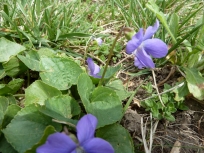
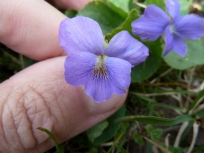 I have been nibbling on a lot of violet flowers and some violet leaves while on
the trail. The flowers are very tasty!
I have been nibbling on a lot of violet flowers and some violet leaves while on
the trail. The flowers are very tasty!
Differentiating between violet species is sometimes difficult (for me). But the new
botanical guide by Arthur Haines,
Flora
Novae Angliae: A Manual for the Identification of Native and Naturalized
Higher Vascular Plants of New England makes it a bit easier. From the pictures
below, you can see the flow of steps used to identify this species of violet:
- Leaves and flower stems arising from rhizomes (underground stems) or stolons (horizontal
stem creeping along the ground).
- Flower petals mostly purple, violet or white.
- Style (thin tube in the center of flower connecting the ovary) in a scoop-shaped
or conical beak. The ovary is hairless.
- The spur (sticking out of the back of the flower) is 3.2mm long or less and less
than 2 times long as it is wide.
- Flowers mostly purple. No stolons produced.
- Leaf blades unlobed.
- Leaf blades less than 1.75 times as long as wide.
- Hairs of the lower flower petals longer than 1mm.
- Sepals (outer lobes of the flower -- often green leaf-like structures at the base
of the flower) are eciliate (without hairs on the edge).
- Sepals are narrowly-egg-shaped to oblong (2-4 times longer than broad) with
a blunt or rounded tip. This one was a close call. If I was wrong in this and the
sepals are lanceolate (lance-shaped -- much longer than wide with widest point
below the middle) and the tip comes to a point, then this violet would be Pectinate-Leaved
Violet (Viola pectinata).
- Leaf blades as wide (or wider) than long and hairless. Side flower petals directed
forward.
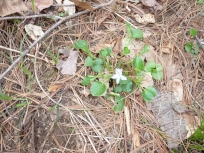
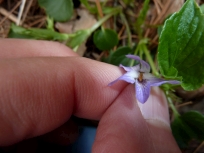 Using the new botanical guide by Arthur Haines,
Flora
Novae Angliae: A Manual for the Identification of Native and Naturalized
Higher Vascular Plants of New England, you can see the flow of steps used to
identify this species of violet:
Using the new botanical guide by Arthur Haines,
Flora
Novae Angliae: A Manual for the Identification of Native and Naturalized
Higher Vascular Plants of New England, you can see the flow of steps used to
identify this species of violet:
- Plants with leafy aerial stems. Flower stems arising from leaf axils.
- Plants perennial from rhizomes (underground stems). Style (thin tube in
the center of flower connecting the ovary) is not globe-shaped at the end/tip.
- Flower petals white, cream, purple or violet.
- Flower petals purple. Sepals eciliate (without hairs on the edge).
- The spur (sticking out of the back of the flower) is 2.8-7mm long.
- Leaf blades are commonly hairless or restricted to the front of the leaf.
April 26, 2012
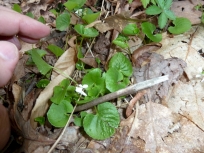
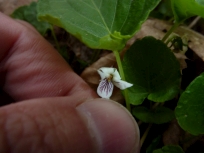 Using the new botanical guide by Arthur Haines,
Flora
Novae Angliae: A Manual for the Identification of Native and Naturalized
Higher Vascular Plants of New England, you can see the flow of steps used to
identify this species of violet:
Using the new botanical guide by Arthur Haines,
Flora
Novae Angliae: A Manual for the Identification of Native and Naturalized
Higher Vascular Plants of New England, you can see the flow of steps used to
identify this species of violet:
- Leaves and flower stems arising from rhizomes (underground stems) or stolons (horizontal
stem creeping along the ground).
- Flower petals mostly purple, violet or white.
- Style (thin tube in the center of flower connecting the ovary) in a scoop-shaped
or conical beak. The ovary is hairless.
- The spur (sticking out of the back of the flower) is 3.2mm long or less and less
than 2 times long as it is wide.
- Flowers relatively smaller with white petals.
- Leaf blades 1.5 times as long (or less) as wide.
- Inner petals of the flower (Corolla) colored white.
- Leaf blades low-crenate (very low, rounded teeth on the edge), thin and hairless.
I could have easily mistaken this with Sweet White Violet (Viola blanda).
According to all of the books I have read, they are easily confused. The leaf
blade margins (edges) are low-serrate (very low saw-like teeth pointing forward).
I find it almost impossible to tell whether these leaves are low-crenate or low-serrate.
Viola blanda var. blanda has a flower stem tinged in red and hairless. The last
two pictures below show the flower stem. The first of the two pictures show that the
top of the flower stem is tinged in red or purple, but the next picture shows that the
rest of the flower stem is green. The problem with it being Viola blanda var. blanda
is that the leaves of that plant come to an acute point at the tip, but the leaves of this
plant have a blunt or rounded tip. The other variation, Viola blanda var.
palustriformis has hairy flower stems and upper lobes of the flower that are not
strongly bent back. The plant in these pictures have a hairless flower stem and
upper lobes of the flower that are strongly bent backwards.
April 27, 2012
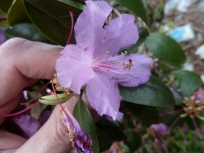
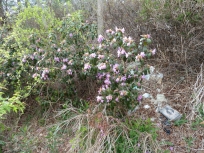 I hope I got this identification right. Most Rhododendron plants bloom in the late
Spring. But Carolina Rhododendron is an early bloomer and combined with a very hot
early Spring in New England, it is flowering in April. The large pink flower matches
what I have seen online.
I hope I got this identification right. Most Rhododendron plants bloom in the late
Spring. But Carolina Rhododendron is an early bloomer and combined with a very hot
early Spring in New England, it is flowering in April. The large pink flower matches
what I have seen online.
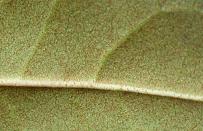
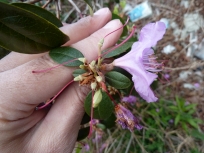 The Carolina Rhododendron is one of two Rhododendrons in New England that have
scales on the back of the leaf. See closeup picture to the right. The other
is the Lapland Rosebay (Rhododendron lapponicum) found on alpine ridge and
plateaus and which grows to only 4-12 inches in height and has smaller flowers.
The Carolina Rhododendron is one of two Rhododendrons in New England that have
scales on the back of the leaf. See closeup picture to the right. The other
is the Lapland Rosebay (Rhododendron lapponicum) found on alpine ridge and
plateaus and which grows to only 4-12 inches in height and has smaller flowers.
April 28, 2012
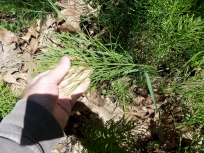
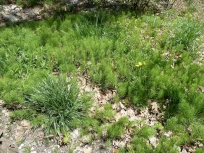 Last year I made a horsetail tincture and later found out that horsetail should
only be taken regularly after it is boiled to deactivate the thiamine
(Vitamin B1)-destroying enzyme, thiaminase. Taken as a decoction, it is useful for
inflammation and the silicon is an important mineral for healthy bones and tissues.
Last year I made a horsetail tincture and later found out that horsetail should
only be taken regularly after it is boiled to deactivate the thiamine
(Vitamin B1)-destroying enzyme, thiaminase. Taken as a decoction, it is useful for
inflammation and the silicon is an important mineral for healthy bones and tissues.
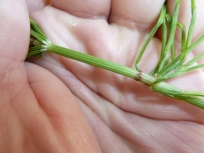
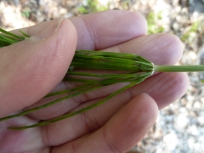 I was surprised that I have never found Field Horsetail in an actual field. I find it
at the sides of dirt and gravel roads and trails. Some of the key distinguishing
features are:
I was surprised that I have never found Field Horsetail in an actual field. I find it
at the sides of dirt and gravel roads and trails. Some of the key distinguishing
features are:
- Whorls of branches coming off the main stem.
- Length of the first internode of the branch is equal to or longer than
the sheath on the stem immediately above the branches. (Click on the first picture in
the second row of pictures to the right.)
- The leaves at the end of each sheath on the main stem are mostly black and without
a prominent white margin.
- Diameter of the stem cavity is 25% or less than the diameter of the whole stem.
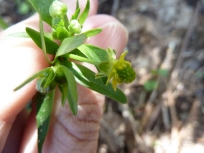
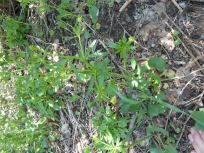 I see quite a bit of these type of plants around, so it is good to know that
they are Buttercup (Ranunculus) and are poisonous upon consumption.
This one is very similar to the Allegheny Mountain Buttercup (Allegheny Crowfoot)
(Ranunculus allegheniensis). The beaks of the achenes (seeds) on Allegheny Mountain
Buttercup are 5 times longer (0.6-1.0 mm) and strongly curved/hooked. The beaks of the
achenes of this plant are closer to 0.1-0.2 mm. See bottom several images below.
Even though the back of some of the sepals (green petals surrounding the flower) is
hairy (see closeup below) as would be Allegheny Mountain Buttercup, without the
long, hooked achene beaks, I think this must be Kidney-Leaved Buttercup.
I see quite a bit of these type of plants around, so it is good to know that
they are Buttercup (Ranunculus) and are poisonous upon consumption.
This one is very similar to the Allegheny Mountain Buttercup (Allegheny Crowfoot)
(Ranunculus allegheniensis). The beaks of the achenes (seeds) on Allegheny Mountain
Buttercup are 5 times longer (0.6-1.0 mm) and strongly curved/hooked. The beaks of the
achenes of this plant are closer to 0.1-0.2 mm. See bottom several images below.
Even though the back of some of the sepals (green petals surrounding the flower) is
hairy (see closeup below) as would be Allegheny Mountain Buttercup, without the
long, hooked achene beaks, I think this must be Kidney-Leaved Buttercup.
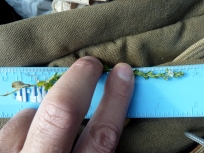
 This little plant would have gone unnoticed, but I sat down on a big rock at the
edge of a parking lot (at a city park) and it was growing next to the rock.
Speedwells are inedible.
This little plant would have gone unnoticed, but I sat down on a big rock at the
edge of a parking lot (at a city park) and it was growing next to the rock.
Speedwells are inedible.
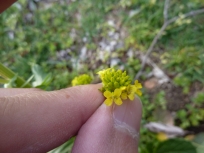
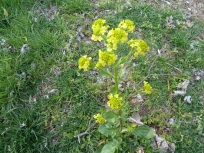
April 29, 2012
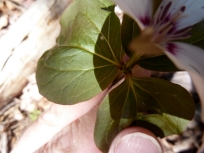
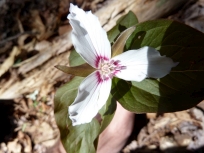 Finally caught Painted Trillium in flower! I found the fruit of Painted Trillium
last year on
July
28, 2011. Painted Trillium is the only Trillium species in New England that
has leaf stems. All of the others have sessile leaves (without leaf stems).
Finally caught Painted Trillium in flower! I found the fruit of Painted Trillium
last year on
July
28, 2011. Painted Trillium is the only Trillium species in New England that
has leaf stems. All of the others have sessile leaves (without leaf stems).
April 30, 2012
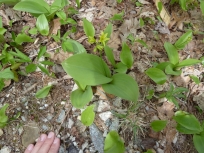
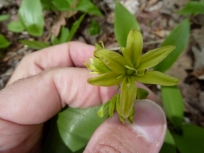 I found Bluebead Lily (Yellow Clintonia) last year on
July
28, 2011 when the plant had inedible blue berry fruit. The plant has 2-3 large
lily leaves that clasp the base. From what I have read, the leaves can be eaten raw
or cooked for 10 minutes when they are very young and unfurled. After the leaves have
unfurled, the taste is no longer pleasant. I missed the harvesting this year!
I found Bluebead Lily (Yellow Clintonia) last year on
July
28, 2011 when the plant had inedible blue berry fruit. The plant has 2-3 large
lily leaves that clasp the base. From what I have read, the leaves can be eaten raw
or cooked for 10 minutes when they are very young and unfurled. After the leaves have
unfurled, the taste is no longer pleasant. I missed the harvesting this year!
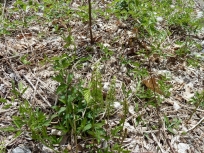
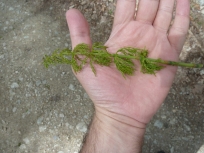 This is the only Horsetail species in New England that commonly has compound
branches coming off the stem. In other words, branches coming off the main stem
split up into smaller branches. Some of the other key distinguishing
features are:
This is the only Horsetail species in New England that commonly has compound
branches coming off the stem. In other words, branches coming off the main stem
split up into smaller branches. Some of the other key distinguishing
features are:
- Whorls of branches coming off the main stem.
- Length of the first internode of the branch is equal to or longer than
the sheath on the stem immediately above the branches. (Click on the first picture in
the table below.)
- The leaves at the end of each sheath on the main stem are brown or read and
are joined into 3 to 4 groups.
- Diameter of the stem cavity is 50% or more than the diameter of the whole stem.
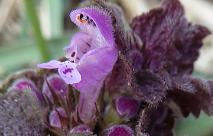
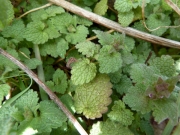
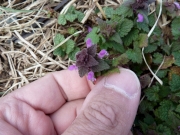
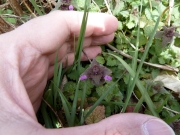
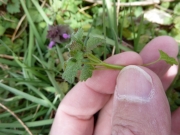

 At first I thought this was a huge plot of Ground Ivy (Glechoma hederacea).
It has a similar look. But Ground Ivy grows closer to the ground and roots at the
nodes while Lamium species do not. Purple Deadnettle has a purple flower with
a hairy, curved hood/lip at the top and two lobes at the bottom. Ground Ivy has a
bluish-purple flower with no hood at the top, a big and slightly split lobe at the
bottom middle and two smaller lobes on each side of the bottom lobe.
At first I thought this was a huge plot of Ground Ivy (Glechoma hederacea).
It has a similar look. But Ground Ivy grows closer to the ground and roots at the
nodes while Lamium species do not. Purple Deadnettle has a purple flower with
a hairy, curved hood/lip at the top and two lobes at the bottom. Ground Ivy has a
bluish-purple flower with no hood at the top, a big and slightly split lobe at the
bottom middle and two smaller lobes on each side of the bottom lobe.
 There are other Lamium species in New Hampshire:
There are other Lamium species in New Hampshire:





 There were no other Queen Anne’s Lace (Wild Carrot) plants in the area,
so I decided not to dig this one up to eat the root.
There were no other Queen Anne’s Lace (Wild Carrot) plants in the area,
so I decided not to dig this one up to eat the root.
 Notice in the last picture (below) how hairy the stems are.
Poison Hemlock (Conium maculatum) has similar-looking leaves,
but is smooth and without hairs.
Notice in the last picture (below) how hairy the stems are.
Poison Hemlock (Conium maculatum) has similar-looking leaves,
but is smooth and without hairs.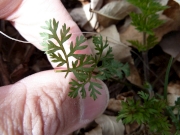
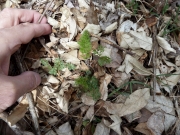
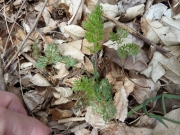
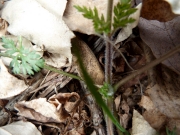

 Luckily, I looked through the calendar section of Arthur Haines' excellent book,
Ancestral Plants (Volume 1) to see what would be available to collect in early
April. American Trout-Lily bulbs were one of several available to collect and from
last year I knew exactly where to find them!
Luckily, I looked through the calendar section of Arthur Haines' excellent book,
Ancestral Plants (Volume 1) to see what would be available to collect in early
April. American Trout-Lily bulbs were one of several available to collect and from
last year I knew exactly where to find them!
 They are much harder to collect than expected. Not only are the bulbs deep in the ground
(for such a small plant), but tree roots get in the way of digging. It take patience
-- much more than I had today. I ate some raw and they were a little bland, but not
bad. I steamed the leaves and bulbs in a metal steamer. Steamed American Trout-Lily
leaves are very good. Last year, when I cooked the leaves in water, they got too
soggy and weren't very good, but steaming is the way to go. The bulbs were just as
bland cooked as raw.
They are much harder to collect than expected. Not only are the bulbs deep in the ground
(for such a small plant), but tree roots get in the way of digging. It take patience
-- much more than I had today. I ate some raw and they were a little bland, but not
bad. I steamed the leaves and bulbs in a metal steamer. Steamed American Trout-Lily
leaves are very good. Last year, when I cooked the leaves in water, they got too
soggy and weren't very good, but steaming is the way to go. The bulbs were just as
bland cooked as raw.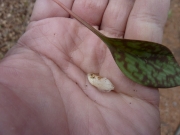
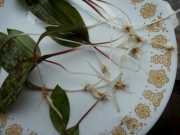
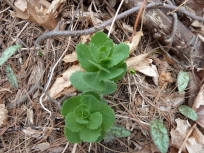
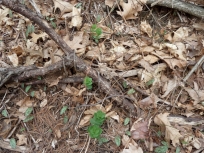

 Last year I focused on learning to identify a variety of edible and non-edible plants.
This year I want to focus on foraging and using wild plants regularly. Today, I went
to the overgrown public gardens area and picked some Common Dandelion, Ground Ivy and
a few leaves of Garlic Mustard for a vegetable medley. I steamed the vegetables and they
were surprisingly mild and good. But it could have used some salt, come to think of it.
Last year I focused on learning to identify a variety of edible and non-edible plants.
This year I want to focus on foraging and using wild plants regularly. Today, I went
to the overgrown public gardens area and picked some Common Dandelion, Ground Ivy and
a few leaves of Garlic Mustard for a vegetable medley. I steamed the vegetables and they
were surprisingly mild and good. But it could have used some salt, come to think of it.
 A couple of things I noticed were that the Common Dandelion grow in direct sunlight and
the leaves had sharp teeth. I expected the leaves to be bitter (since it is my understanding
that dandelion grown in shade is less bitter), but it was mild. This may be due to the
leaves being so young. Adding a few Garlic Mustard leaves did not make the dish bitter.
I have read that bigger, older Garlic Mustard leaves tend to be less bitter.
A couple of things I noticed were that the Common Dandelion grow in direct sunlight and
the leaves had sharp teeth. I expected the leaves to be bitter (since it is my understanding
that dandelion grown in shade is less bitter), but it was mild. This may be due to the
leaves being so young. Adding a few Garlic Mustard leaves did not make the dish bitter.
I have read that bigger, older Garlic Mustard leaves tend to be less bitter.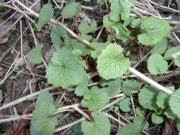
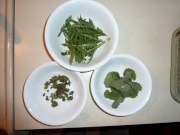
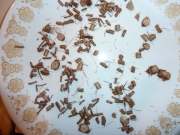

 This is one of the best medicines for sore throats. Both the golden root and the above-ground
part of the plant can be used to make a tincture or tea. In addition, the root can be chewed
for immediate effect. The root is so bitter that it will make you forget that you have
a sore throat. In fact, the bitterness will make you forget you have a throat at all!
This is one of the best medicines for sore throats. Both the golden root and the above-ground
part of the plant can be used to make a tincture or tea. In addition, the root can be chewed
for immediate effect. The root is so bitter that it will make you forget that you have
a sore throat. In fact, the bitterness will make you forget you have a throat at all!
 I am not sure why I could not find this plant last year. It is all over the place in
this forest of Eastern White Pine, Eastern Hemlock and American Beech trees.
I am not sure why I could not find this plant last year. It is all over the place in
this forest of Eastern White Pine, Eastern Hemlock and American Beech trees.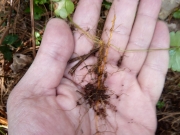
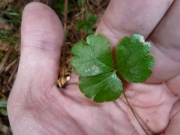
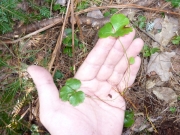
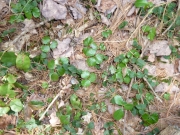

 This plant was growing in a 30-foot wide, 6-inch to 2-feet deep stream. Some of the
plants were partially above the water and some were in the middle of the steam several
inches below the water. It looked like watercress. After futile attempts to confirm
identification, I sent a couple of pictures to Arthur Haines and he suggested that
it looks like Pennsylvania Bittercress, but he couldn't be certain from the two pictures
I sent.
This plant was growing in a 30-foot wide, 6-inch to 2-feet deep stream. Some of the
plants were partially above the water and some were in the middle of the steam several
inches below the water. It looked like watercress. After futile attempts to confirm
identification, I sent a couple of pictures to Arthur Haines and he suggested that
it looks like Pennsylvania Bittercress, but he couldn't be certain from the two pictures
I sent.
 I will need to do more work to confirm identification. I have narrowed it down to one
of the following:
I will need to do more work to confirm identification. I have narrowed it down to one
of the following: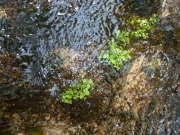
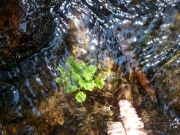
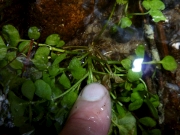
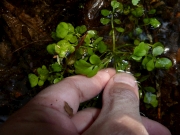

 I have been nibbling on a lot of violet flowers and some violet leaves while on
the trail. The flowers are very tasty!
I have been nibbling on a lot of violet flowers and some violet leaves while on
the trail. The flowers are very tasty!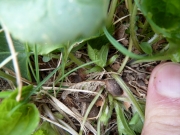
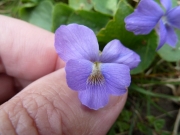
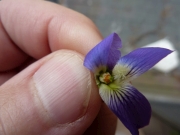
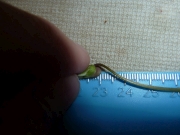
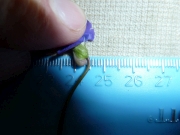
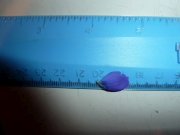
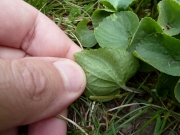
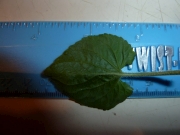
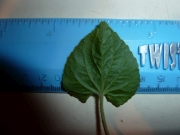
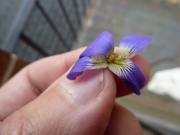
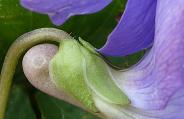
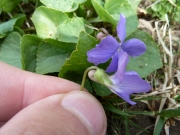
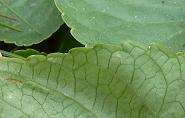

 Using the new botanical guide by Arthur Haines,
Flora
Novae Angliae: A Manual for the Identification of Native and Naturalized
Higher Vascular Plants of New England, you can see the flow of steps used to
identify this species of violet:
Using the new botanical guide by Arthur Haines,
Flora
Novae Angliae: A Manual for the Identification of Native and Naturalized
Higher Vascular Plants of New England, you can see the flow of steps used to
identify this species of violet: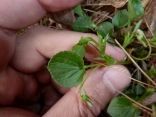
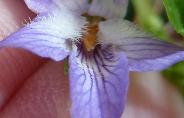
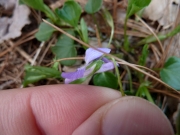

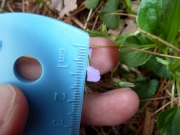
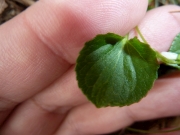
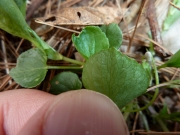
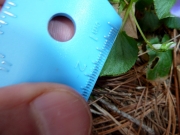
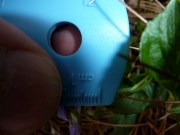
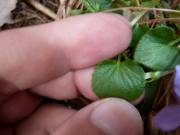

 Using the new botanical guide by Arthur Haines,
Flora
Novae Angliae: A Manual for the Identification of Native and Naturalized
Higher Vascular Plants of New England, you can see the flow of steps used to
identify this species of violet:
Using the new botanical guide by Arthur Haines,
Flora
Novae Angliae: A Manual for the Identification of Native and Naturalized
Higher Vascular Plants of New England, you can see the flow of steps used to
identify this species of violet: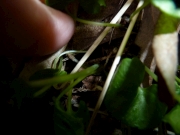
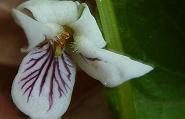
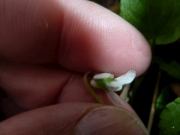
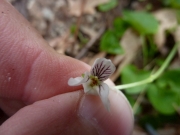
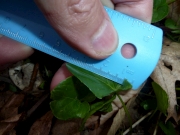

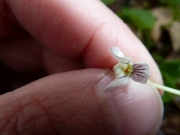
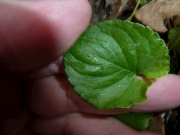
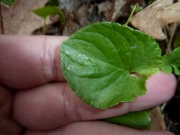
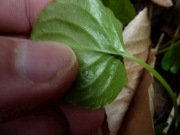
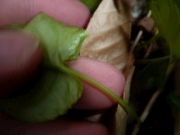
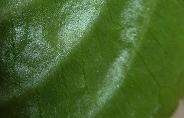
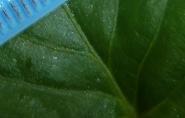
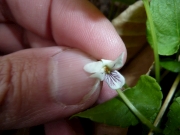
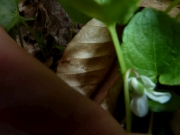
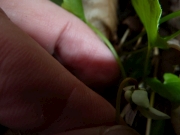
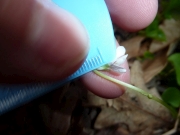

 I hope I got this identification right. Most Rhododendron plants bloom in the late
Spring. But Carolina Rhododendron is an early bloomer and combined with a very hot
early Spring in New England, it is flowering in April. The large pink flower matches
what I have seen online.
I hope I got this identification right. Most Rhododendron plants bloom in the late
Spring. But Carolina Rhododendron is an early bloomer and combined with a very hot
early Spring in New England, it is flowering in April. The large pink flower matches
what I have seen online.
 The Carolina Rhododendron is one of two Rhododendrons in New England that have
scales on the back of the leaf. See closeup picture to the right. The other
is the Lapland Rosebay (Rhododendron lapponicum) found on alpine ridge and
plateaus and which grows to only 4-12 inches in height and has smaller flowers.
The Carolina Rhododendron is one of two Rhododendrons in New England that have
scales on the back of the leaf. See closeup picture to the right. The other
is the Lapland Rosebay (Rhododendron lapponicum) found on alpine ridge and
plateaus and which grows to only 4-12 inches in height and has smaller flowers.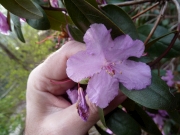
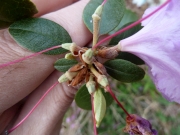
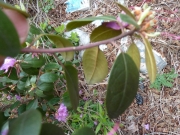
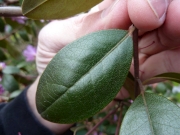
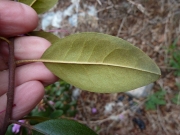
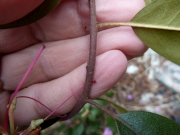
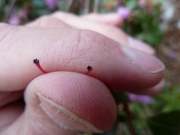
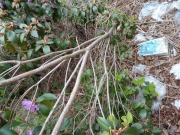
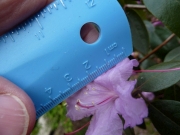
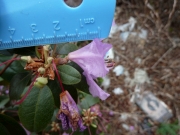
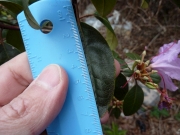
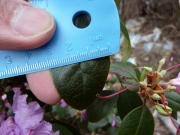
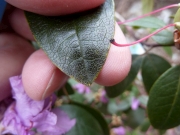
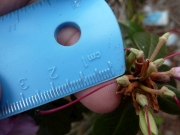
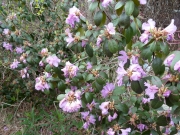

 Last year I made a horsetail tincture and later found out that horsetail should
only be taken regularly after it is boiled to deactivate the thiamine
(Vitamin B1)-destroying enzyme, thiaminase. Taken as a decoction, it is useful for
inflammation and the silicon is an important mineral for healthy bones and tissues.
Last year I made a horsetail tincture and later found out that horsetail should
only be taken regularly after it is boiled to deactivate the thiamine
(Vitamin B1)-destroying enzyme, thiaminase. Taken as a decoction, it is useful for
inflammation and the silicon is an important mineral for healthy bones and tissues.
 I was surprised that I have never found Field Horsetail in an actual field. I find it
at the sides of dirt and gravel roads and trails. Some of the key distinguishing
features are:
I was surprised that I have never found Field Horsetail in an actual field. I find it
at the sides of dirt and gravel roads and trails. Some of the key distinguishing
features are: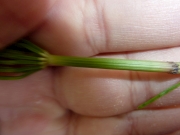
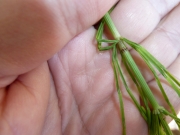
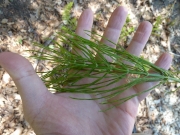
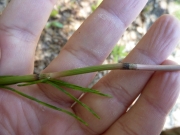
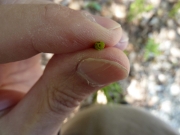
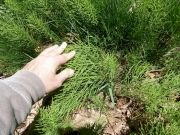
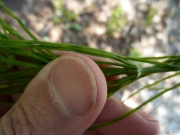

 I see quite a bit of these type of plants around, so it is good to know that
they are Buttercup (Ranunculus) and are poisonous upon consumption.
This one is very similar to the Allegheny Mountain Buttercup (Allegheny Crowfoot)
(Ranunculus allegheniensis). The beaks of the achenes (seeds) on Allegheny Mountain
Buttercup are 5 times longer (0.6-1.0 mm) and strongly curved/hooked. The beaks of the
achenes of this plant are closer to 0.1-0.2 mm. See bottom several images below.
Even though the back of some of the sepals (green petals surrounding the flower) is
hairy (see closeup below) as would be Allegheny Mountain Buttercup, without the
long, hooked achene beaks, I think this must be Kidney-Leaved Buttercup.
I see quite a bit of these type of plants around, so it is good to know that
they are Buttercup (Ranunculus) and are poisonous upon consumption.
This one is very similar to the Allegheny Mountain Buttercup (Allegheny Crowfoot)
(Ranunculus allegheniensis). The beaks of the achenes (seeds) on Allegheny Mountain
Buttercup are 5 times longer (0.6-1.0 mm) and strongly curved/hooked. The beaks of the
achenes of this plant are closer to 0.1-0.2 mm. See bottom several images below.
Even though the back of some of the sepals (green petals surrounding the flower) is
hairy (see closeup below) as would be Allegheny Mountain Buttercup, without the
long, hooked achene beaks, I think this must be Kidney-Leaved Buttercup.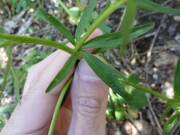
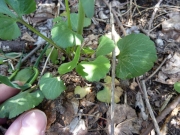
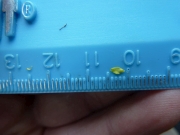
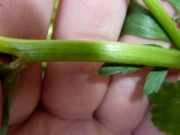
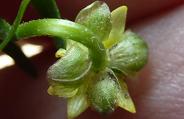
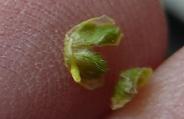
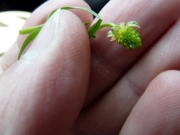
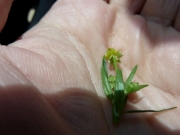
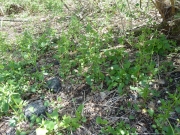
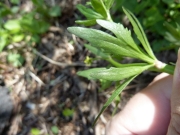
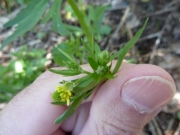
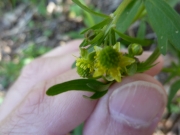
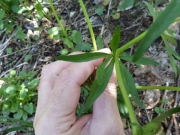
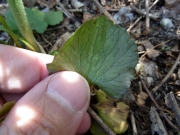
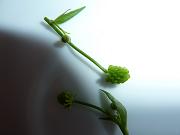
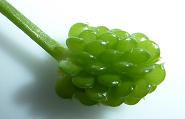
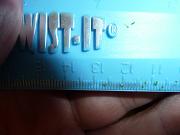
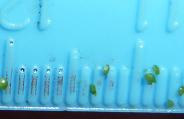

 This little plant would have gone unnoticed, but I sat down on a big rock at the
edge of a parking lot (at a city park) and it was growing next to the rock.
Speedwells are inedible.
This little plant would have gone unnoticed, but I sat down on a big rock at the
edge of a parking lot (at a city park) and it was growing next to the rock.
Speedwells are inedible.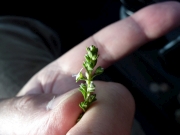
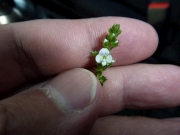
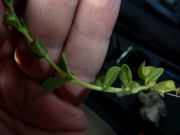

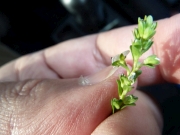
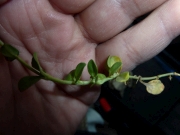
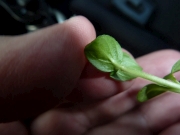
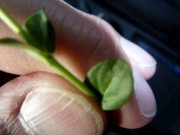
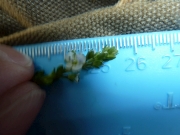
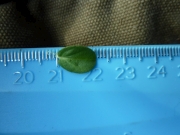
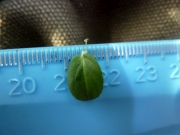
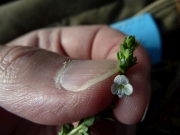
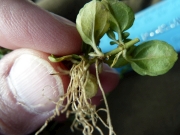


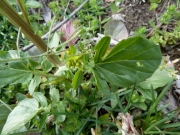
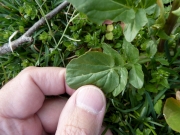
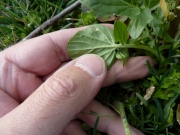
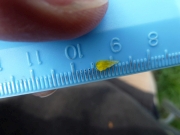
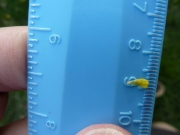
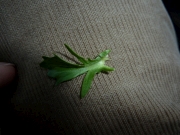
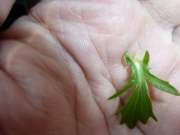
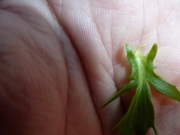
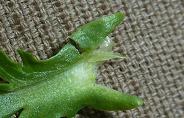
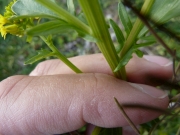
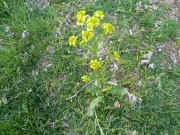
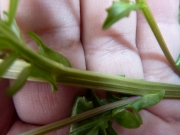
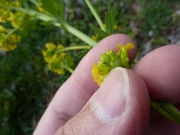
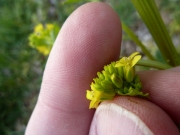
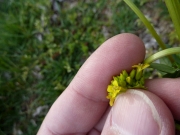
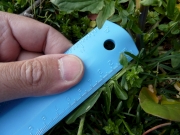
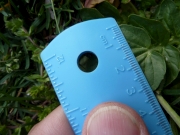
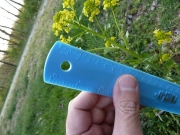
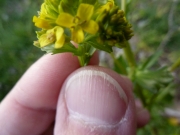

 Finally caught Painted Trillium in flower! I found the fruit of Painted Trillium
last year on
July
28, 2011. Painted Trillium is the only Trillium species in New England that
has leaf stems. All of the others have sessile leaves (without leaf stems).
Finally caught Painted Trillium in flower! I found the fruit of Painted Trillium
last year on
July
28, 2011. Painted Trillium is the only Trillium species in New England that
has leaf stems. All of the others have sessile leaves (without leaf stems).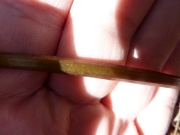
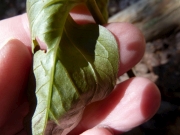
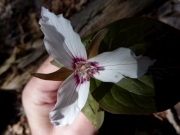
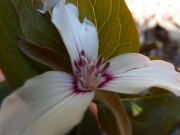
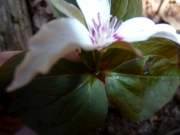
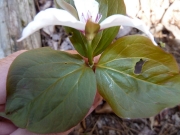
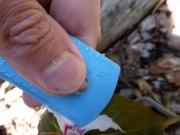
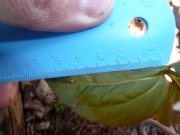

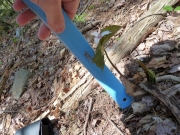

 I found Bluebead Lily (Yellow Clintonia) last year on
July
28, 2011 when the plant had inedible blue berry fruit. The plant has 2-3 large
lily leaves that clasp the base. From what I have read, the leaves can be eaten raw
or cooked for 10 minutes when they are very young and unfurled. After the leaves have
unfurled, the taste is no longer pleasant. I missed the harvesting this year!
I found Bluebead Lily (Yellow Clintonia) last year on
July
28, 2011 when the plant had inedible blue berry fruit. The plant has 2-3 large
lily leaves that clasp the base. From what I have read, the leaves can be eaten raw
or cooked for 10 minutes when they are very young and unfurled. After the leaves have
unfurled, the taste is no longer pleasant. I missed the harvesting this year!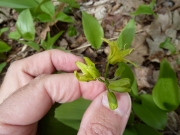
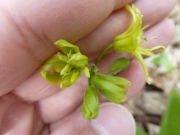
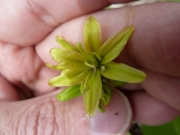
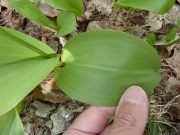
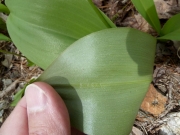
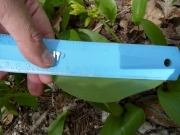

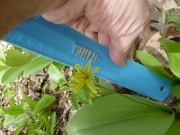

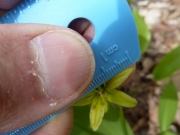

 This is the only Horsetail species in New England that commonly has compound
branches coming off the stem. In other words, branches coming off the main stem
split up into smaller branches. Some of the other key distinguishing
features are:
This is the only Horsetail species in New England that commonly has compound
branches coming off the stem. In other words, branches coming off the main stem
split up into smaller branches. Some of the other key distinguishing
features are: